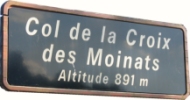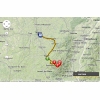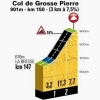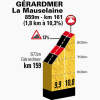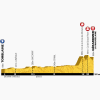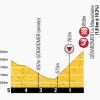The first ascent is the longest. Col de la Croix des Moinats is 7.6 kilometres long and ascends by an average gradient of 6%. It’s a steady climb to suit the diesels. The steepest section is between kilometre 5 and 6, where it rises to 7.4%, and immediately after that it flattens to around 3% before the riders crest the summit.
The descent is 5 kilometres long and then the next col lays waiting, so not much opportunity to close a gap.
Col de Grosse Pierre
De Col de Grosse-Pierre is a short and venomous ascent. In 3 kilometres riders gain 325 metres, meaning an average gradient of 7.5%, but in fact this doesn’t really tell the whole story. The opening kilometre is just 3% and the closing kilomtre is similar. The rest of the climb has a 10% gradient. In comparison: the Mur du Huy is 1.3 kilometres long at almost 10%, so the middle section at the Grosse-Pierre is something similar.
Unlike the Croix des Moinats, the Col de Grosse-Pierre is not a first in the Tour de France. Used first in 1913 and again recently when Chris Anker Sørensen was the first rider to the top in 2012. The road being used this year is new however. ASO’s Thierry Gouvenou discovered the road on Google Earth and it reminded him of… well… the Mur du Huy. The new route to the top features in a local motor race, with the nickname of the ‘impossible climb’.
Upon cresting it’s a 9 kilometre descent to the bottom of the next climb.
Gérardmer La Mauselaine
The closing climb is 1.8 kilometres long to the ski resort La Mauselaine. A short distance in which riders head from a height of 673 metres to 859 metres, a vertical gain of 184 altimetres meaning an average gradient of 10.3%. The steepest section is 13%, faced with 500 metres to go.
The fastest riders will get from the bottom to the top of the climb in about 6 minutes.
Tour de France stage 8: Images and more!
Click on the images to zoom
